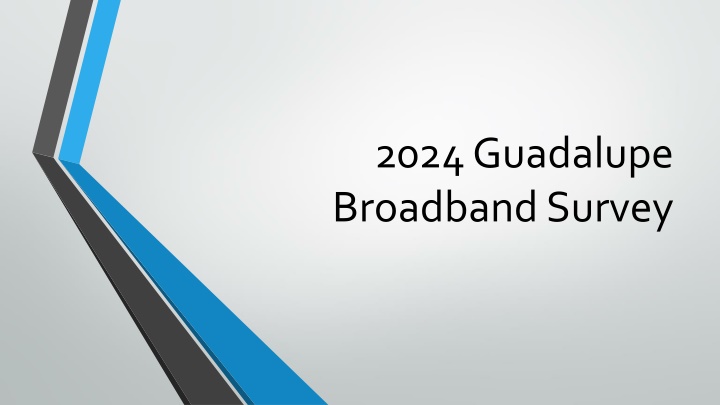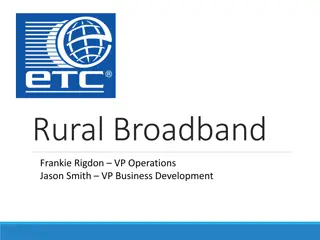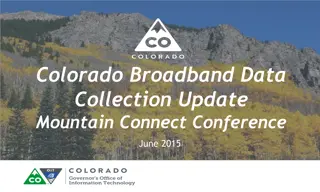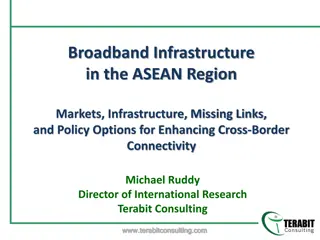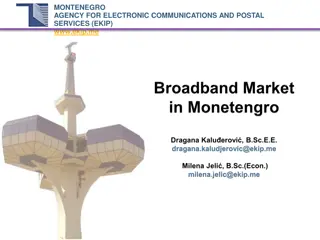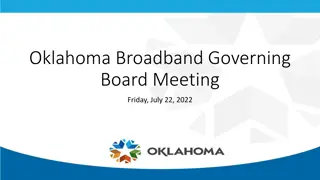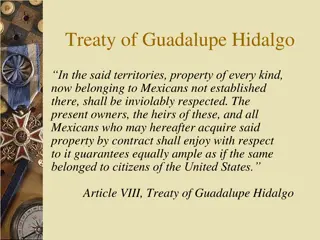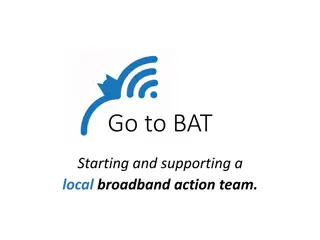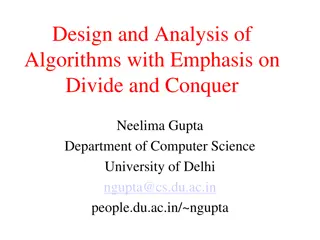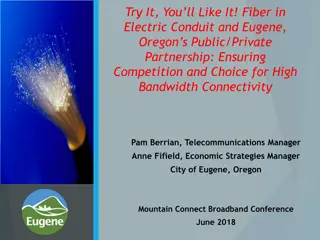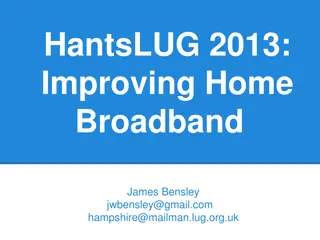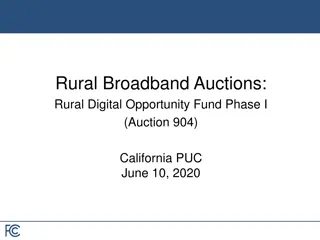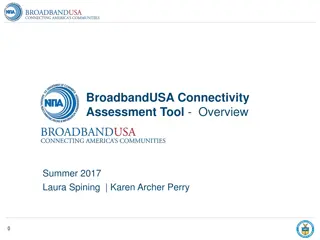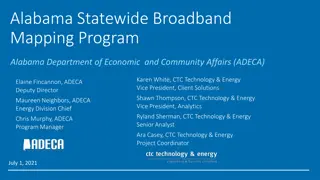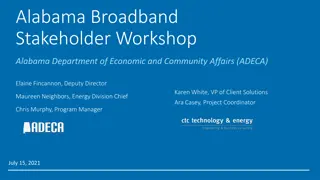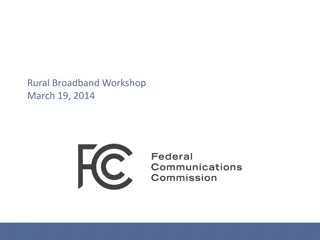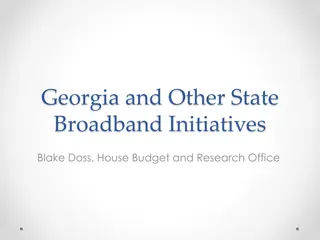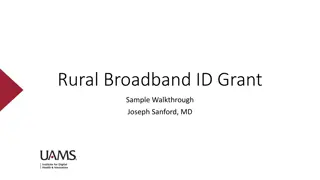Guadalupe Broadband Survey 2024 - Bridging the Divide and Enhancing Business Innovation
The Guadalupe Broadband Navigator Project aims to gather precise data on broadband services in Guadalupe, California to inform strategic broadband deployment decisions. By focusing on bridging the digital divide and enhancing business efficiency, the project seeks to improve equity and attract new businesses to the area. Through detailed location analysis and thoughtful survey development, the initiative prioritizes inclusivity by offering surveys in both English and Spanish to overcome language and cultural barriers.
Uploaded on Mar 12, 2025 | 1 Views
Download Presentation

Please find below an Image/Link to download the presentation.
The content on the website is provided AS IS for your information and personal use only. It may not be sold, licensed, or shared on other websites without obtaining consent from the author.If you encounter any issues during the download, it is possible that the publisher has removed the file from their server.
You are allowed to download the files provided on this website for personal or commercial use, subject to the condition that they are used lawfully. All files are the property of their respective owners.
The content on the website is provided AS IS for your information and personal use only. It may not be sold, licensed, or shared on other websites without obtaining consent from the author.
E N D
Presentation Transcript
2024 Guadalupe Broadband Survey
Why we did it The Guadalupe Broadband Navigator Project was created to get the most accurate data available on the baseline existence and quality of broadband services within the city of Guadalupe, California. Conceived as a census-style survey administered door-to-door, this data would be used by organizations and/or departments within City, County, State, and Federal agencies to help make decisions for the most effective deployment of ubiquitous broadband solutions for the city and county.
In addition to bridging the digital divide and improving equity within the residential population, there is significant evidence of a strong relationship between broadband availability and business efficiency and innovation. Without access to reliable broadband within the business districts including the downtown business corridor, as well as the manufacturing and industrial areas the ability for the city to attract new businesses will be at a significant disadvantage.
How We Did It Location Analysis Location Analysis Because this was meant to be a census-style survey, there were going to be multiple canvassers going door-to-door. The city would have to be broken up in such a way that canvassers would be able to maximize their efficiency and not tread the same ground that other canvassers may already have completed. Additionally, because there was a focus on utilizing canvassers from within the community rather than employing personnel from outside the area creating districts allowed canvassers to select areas that they felt that they were familiar with the population and languages spoken therein.
How We Did It There were 15 districts that covered the entirety of the city District 1 was at the westernmost side of the map. Districts 8 and 9 were on the southern border of the city map and were comprised of the new Pasadera development. Districts 10 and 11 provided the eastern side of town known as the Treasure Park area, and Districts 12 and 13 bordered the northernmost edge of town. Districts 7, 13, 14, and 15 included residences as well as the downtown business corridor (retail, restaurants, commercial, industrial and manufacturing).
How We Did It Survey Development Survey Development Significant thought was put into the development of the broadband survey. Above all, the focus needed to be on the surveys being simple and direct. During the development process, we asked ourselves the question, What is the point of the survey? This was foundational because the survey needed to reach as many people in the community as possible. We knew that there were language barriers. We suspected that there might be cultural barriers as well; this in reference to both racial and age-related culture. To be as inclusive as possible we felt the surveys needed to be short, to the point, and available in English and Spanish.
How We Did It The questions were developed to be easily understood and to focus on the following: 1.a baseline of Internet connectivity from the entire community not just those that had access to broadband 2.the level of available service for those that had it 3.a baseline of understanding when it came to two key industry marketing terms: Broadband and Fiber 4.why or why not survey respondents used their Internet connection 5.if there was community interest in the provisioning of broadband as a public utility
How We Did It Canvasser Recruitment Canvasser Recruitment One of the unique features of the Guadalupe Broadband Survey was its focus on utilizing local canvassers to conduct the survey. This was based on the hypothesis that there would be a stronger survey response from an in-person request versus an impersonal postal or online survey. As a result of these efforts, canvassers were either living in Guadalupe or Santa Maria and were former residents of Guadalupe or parts of organizations that were active within the city.
How We Did It Data Collection Data Collection The data collection process went relatively smoothly. Several web-based resources have charted the success of survey responses. Some of these metrics include: 33% as the average response rate for all survey channels, including in-person and digital a good survey response rate ranges between 5% and 30%. An excellent response rate is 50% or higher. Response rates vary widely for different types of surveys. Customer satisfaction surveys and market research surveys often have response rates in the 10% 30% range.
How We Did It Data Collection Data Collection The data collection process went relatively smoothly. Several web-based resources have charted the success of survey responses. Some of these metrics include: 33% as the average response rate for all survey channels, including in-person and digital a good survey response rate ranges between 5% and 30%. An excellent response rate is 50% or higher. Response rates vary widely for different types of surveys. Customer satisfaction surveys and market research surveys often have response rates in the 10% 30% range. The aggregate survey response rate for the Guadalupe Broadband Survey was 48.35%.
Key Results Are You Connected? Are You Connected? The most basic question of connectivity provided a clear indication that broadband was available and used within the city. Q1: Are you connected to the Internet at home? Yes No 998 99 1097 Total Respondents
Key Results How Are You Connected? How Are You Connected? Q2: How are you connected? The majority of respondents connected via WiFi. Just over half of respondents connected via a hardwire or a wire-based connection (RJ-45 Ethernet cable or Fiber Optic). Much smaller percentages used Cellular Hotspots, Satellite connections or only used their Cell Phones to connect. Hardwired 568 54% WiFi 857 81% Cellular Hotspot 21 2% Cell Phone Only 33 3% Satellite 17 2% Total Respondents 1060
Key Results Speed & Reliability Satisfaction? Speed & Reliability Satisfaction? The majority of respondents connected via WiFi. Just over half of respondents connected via a hardwire or a wire-based connection (RJ-45 Ethernet cable or Fiber Optic). Much smaller percentages used Cellular Hotspots, Satellite connections or only used their Cell Phones to connect. Q3: Does your connection speed meet your needs? Q4: Is your connection performance reliable enough for your needs? Yes 746 77% Yes 710 74% No 210 22% No 233 24% Sometimes 14 1% Sometimes 14 1% Total Respondents 970 Total Respondents 957
Key Results So data suggest that most people are satisfied; however, CONTEXT MATTERS! The case study at the end of the presentation will show why.
Key Results Q5: Please list your Service Provider Advanced Wireless Who do you use? Who do you use? 1 0.11% AT&T 2 0.22% Comcast 2 0.22% DirecTV 1 0.11% Spectrum accounted for nearly 91% of service of survey respondents. The largest competitor was Frontier and they accounted for less than 6% of the respondent market share. Dish 3 0.33% Frontier 48 5.21% Integrity 1 0.11% Metro 3 0.33% Netgear 1 0.11% Other - Non-Specific 6 0.65% School 2 0.22% Spectrum 836 90.67% T-Mobile 10 1.08% Verizon 5 0.54% Viasal Programa 1 0.11% Total Respondents 922
Key Results Why do you use it? Why do you use it? Q6: What do you use your service for? The top reason for usage was entertainment. Education was next on the list with 75% of the respondents citing that as their reason for using their connectivity. Shopping and working from home were nearly equal at 55-56%. Gaming and healthcare were the next tier at 47% and 45%, respectively. Other was cited by about 10% of respondents and reasons included business transactions (e.g. point of sale systems), social media, and online banking. Work from Home 503 55% Education 685 75% Healthcare 409 45% Shopping 510 56% Movies, TV, Sports, or Other Media Streaming 771 84% Gaming 434 47% Other 91 10% Total Respondents 915
Key Results What are you even talking about? What are you even talking about? What is interesting is that over half the survey respondents that ARE currently connected to the Internet don t understand the basic terms of Broadband or Fiber, even though they are dominant key words that is used in industry marketing materials. It is not surprising that the corresponding numbers increase for those that are not connected. We feel that providing educational opportunities for the local community can help with baseline understanding of technology so that they can make better decisions as consumers.
Key Results Non Non- -Connected Users Connected Users Connected Users Connected Users Q7: Do you Understand the term "Broadband" as it relates to the Internet? Q3: Do you Understand the term "Broadband" as it relates to the Internet? Yes 446 46% Yes 19 21% No 515 53% No 71 79% Maybe 3 0% Total Respondents 90 Total Respondents 964 Q4: Do you Understand the term "Fiber" as it relates to the Internet? Q8: Do you Understand the term "Fiber" as it relates to the Internet? Yes 18 20% Yes 372 38% No 597 62% No 72 80% Maybe 1 0% Total Respondents 90 Total Respondents 970
Key Results Broadband as a Utility? Broadband as a Utility? We asked if respondents would consider using an Internet Service if it were a public utility like water or trash? Connected Users Connected Users Non Non- -Connected Users Connected Users Q9: Would you consider using an Internet Service if it were a public utility like water or trash? Q5: Would you consider using an Internet Service if it were a public utility like water or trash? Yes 814 85% Yes No 52 34 60% 39% 1% No 127 17 13% 2% Maybe 1 Maybe Total Respondents 87 Total Respondents 958
Key Results Why are you NOT Connected? Why are you NOT Connected? Nearly half of those without service said that they did not need it. This could be due to access at work or another location like a library. There was also a large percentage of those without service that mentioned that cost was a factor. This was interesting considering the high percentage of Affordable Connectivity Program (ACP) users in Guadalupe. Guadalupe had one of the highest ACP enrollment percentages on the Central Coast in fact, at 95%, it is the highest percentage of qualified enrolled households in Santa Barbara County11. The ACP unfortunately has been discontinued and it is a question to know if these numbers would now change. Q2: Why are you not connected? Don't Need it 43 46% No Service Available 4 4% Not Affordable 37 40% Other 14 15% Total Respondents 93
Key Results Some Canvasser Thoughts Some Canvasser Thoughts Some community members thought we were selling things or questioned survey legitimacy. Would have been better if notified directly by the city some asked for City business cards or other leave behinds. Change of the sponsor from LADG to FSA made some people cautious. Some would have liked an online option. Possibly there was a competitive survey by Frontier around the same time. Most people seemed to feel that there were no good pathways of communication in the city. General feeling that the city does not care about the citizens they feel ignored. Many were surprised that the city actually wanted their opinion. Interestingly, age seemed to be separated by district with some canvassed districts primarily 40+ and others with lots of kids. Language was more consistent across all canvassed districts although Mixteco was very concentrated in one of the districts we canvassed. Lots of people think a change would be a good thing for the residents. Because Charter/Spectrum is a monopoly, competition would provide better costs or services. Internet is a necessary thing for medical and online bills and education and it is very important thing to address. Hearing things like the need more lighting for kids and other safety improvements, more than once, it seems that the city needs a better way to communicate more broadly with its citizens. More information in more languages. More transparency with budgets and how money is used because there is distrust in where publicized money goes. This could be done with more information in the water bills. Great opportunity for Guadalupe. Many support the possibility of having it be invoiced with/like utilities.
CASE STUDY Remember Context? Remember Context? At the end of November, 2023, we were notified that the state had received an official objection from Spectrum/Charter Communications related to the rural middle mile network project by Golden State Connect Authority (GSCA). Golden State Connect is a joint powers authority comprised of 40 rural California counties designed for the purpose of increasing access to reliable, affordable high-speed internet for the residents and businesses of those counties. In part, Spectrum/Charter objected because information demonstrates that Charter can provide broadband service in the Project Area with service far exceeding the minimum speed thresholds set forth in the FFA Program Guidelines.
CASE STUDY Out of the 922 question respondents, we received the following information: Key Aggregate Totals 922 Total Respondents 687 74.51% Connection Speed Needs Met 233 25.27% Connection Speed Needs NOT Met 22 2.39% Connection Speed Met Sometimes 646 70.07% Reliability Needs Met 293 31.78% Reliability Needs NOT Met 18 1.95% Reliability Needs Met Sometimes
CASE STUDY But, CONTEXT! While those numbers out of context paint a picture that supports Spectrum s objection that they already adequately service the area, a deeper dive into the survey responses paints a slightly different picture: Eight (8) out of 15 districts had 30% or more respondents complain that connection speed did not meet their needs Ten (10) out of 15 districts had 30% or more respondents complain that service reliability did not meet their needs
CASE STUDY The spread of discontent can be presented in a visual format using a district map overlay. While there were a few areas (all adjacent to each other) that reported satisfactory services, dissatisfaction over speed and reliability were much more widespread across the city. It could certainly be argued that while there are existing services throughout the city, it does not appear to meet the needs of many of the population.
CONCLUSIONS Availability and Satisfaction Availability and Satisfaction While broadband appears to be available more so than public comments might lead one to believe, the speed and reliability of the provided services do appear to be an issue. While there are some areas of the city that appear to be just fine, almost three quarters of the city harbors fairly significant issues with the incumbent service providers. Ten of fifteen reporting districts had at least 20% of survey respondents dissatisfied with speed. In fact, seven of those districts had dissatisfaction levels as high as 40%. Even more telling was that twelve of the fifteen surveyed districts had at least 20% of respondents unhappy about reliability. Four of those districts had up to 50% of all respondents reporting dissatisfaction with reliability. When significant numbers of the population are dissatisfied with the service level of incumbents, it becomes obvious that alternative solutions need to be explored.
CONCLUSIONS Understanding & Education Understanding & Education It is also readily apparent that even if people use broadband service, they may not understand the basic terms that they are using and paying for. This educational issue becomes more glaring when respondents did not have a connection. This leads us to believe that educational opportunities pertaining to basic connectivity would benefit the community.
CONCLUSIONS Future Services Future Services Finally, according to all respondents, there was a significant desire to consider the provisioning of Internet services as a public utility. This may certainly provide insight to the County and State as to what solutions might be the best fit for this rural community.
ACKNOWLEDGEMENTS Thank You! Thank You! The survey coordinator and Guadalupe Broadband Taskforce would like to extend its thanks and gratitude to the Santa Barbara Foundation to make this survey a reality. Also, thank you to Los Amigos de Guadalupe, Broadband Consortium Pacific Coast, Guadalupe Business Association, Guadalupe Coalition of Nonprofits, the City of Guadalupe, and other organizations who helped share the information about this survey and to make it possible. A special thank you to Family Service Agency who stepped into fiscal agency part way through and allowed it to cross the finish line. The following individuals also deserve to be singled out for their assistance throughout the process: Petra Amaro, Rubayi Estes, Liz Thasiah, Shelby Arthur, Lisa Brabo, Arcelia Sencion, Bill Bartels and AITR.
